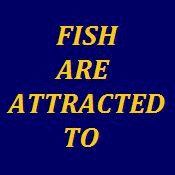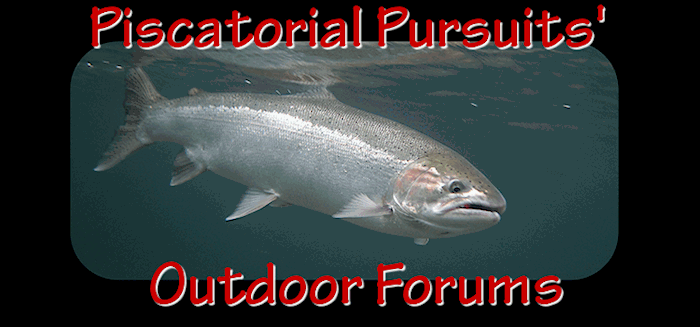#183548 - 01/26/03 02:18 PM
 Hatchery-raised definition?
Hatchery-raised definition?
|

WINNER

Registered: 01/11/03
Posts: 10363
Loc: Olypen
|
I know I am opening a can of worms here, but I'm trying to get things clear in my head. I actually have a number of questions, so feel free to jump in. (1) What constitutes a hatchery-raised fish? The reason I ask is because to me, hatchery-raised fish are those that are raised to something larger that fry-size, i.e., pen-fed fish in rearing ponds. I don't regard hatching eggs and planting fry as hatchery-raised. To me all that constitutes is giving the brood stock a better chance at reproducing. Does that weaken a fish? How does it damage anything to plant fry in the water systems? It would seem to me that if the dispersal of fry is well planned and spread out, and that if hatchery-borne diseases are closely monitored, that the numbers of wild fish could be greatly and quickly increased, and at a much lower cost. I have heard and read about egg-hatching protective cages buried in selected spots designed to do the same thing. How are these working out? Here's a compromised-gene-pool question. Have there been studies done to determine which genes are dominate and which are recessive (or is it regressive?) in fish? I don't know the answer to this, but it seems to me that the dominate genes would be the ones associated with all of the necessary survival characteristics, and will nearly always predominate in a mix of "hatchery and wild" fish. Like a blue-eye, brown-eye cross nearly always produces a brown eye. Is there documented evidence of damage to wild fish populations by hatchery-raised fish? I have heard an awful lot of selective and subjective theology (whatever happened to science objectivity?  ). I am not impressed with the uprooted spawn theory or the too many fish in a river theory, as there are numerous rivers in Alaska that have so many fish in them every year that the eddys are filled with uprooted spawn. Yet those rivers continue to produce massive numbers of fish. I'm guessing that if the fish-demand for food exceeds the river's capability to provide, then some of the fry die off and provide food for the remaining fry? The DNA thing can no longer be argued as well, since both wild and hatchery fish can not be shown to be genetically different. (Who the Hell is responsible for lending credibility to that creative science? 
_________________________
Agendas kill truth.
If it's a crop, plant it.
|
|
Top
|
|
|
|
#183549 - 01/26/03 06:46 PM
 Re: Hatchery-raised definition?
Re: Hatchery-raised definition?
|

Dick Nipples

Registered: 03/08/99
Posts: 27839
Loc: Seattle, Washington USA
|
Fun5,
I guess I'd divide the fish up into three types...
First, wild, native fish; those hatched from fish who carry the stream's specific genetic material and are spawned, hatched, reared, and migrate out of and back into the wild. No interference by man.
Second, wild, non-native fish. Same as "native", but have one or more ancestor with non-native genetics, i.e., a hatchery fish ancestor.
Lastly, hatchery fish; anything that's not in the above. The second that eggs or sperm are removed from the wild and handled/protected by man, the result will be a hatchery fish. The main reason for this would be that any artificial increase in survival, at any stage, is removing the total activity of natural selection from the equation. Maybe not all of it, and maybe just a little bit of it, but some of it. It can't later become a "native" or "wild" fish because it is released into the wild, whether it be at the eyed egg stage, fry, parr, smolt, or adult stage.
As far as documented damage to wild fish from hatchery fish, the newest and best science all agrees that the answer is a resounding yes.
While there are obvious concerns like disease, predation, and competition among different size parr/smolts for food, space, etc., the most obvious damages come from hatchery fish that are allowed to spawn in the wild.
Studies in Canada (the Keogh R., I believe) and here in Washington, specifically the Kalama River, all show that hatchery/hatchery crosses have almost non-existent success in creating returning adult fish.
They also go on to show that hatchery/wild crosses have a greatly reduced capacity for returning adult fish, though it is somewhat better than HxH crosses.
Both HxW and HxH crosses utilize good spawning areas, and produce lots of smolts, both of which are problems for the much more successful WxW crosses, not to mention that a wild fish is wasted in a HxW cross as it's genetic material is not successfully passed on to create returning adults.
Though the jury is still out, evidence is starting to accumulate that wild broodstock programs are pretty damaging, too. I apologize for not having the study specifics handy, but the results are something like this...
If twenty pairs of wild fish spawn in the wild, they produce a certain amount of smolts, and a certain amount of returning adults. Those returning adults, of course, are wild fish, too.
If those same twenty pairs are captured and spawned in a broodstock program, they produce more smolts, but about the same or less returning adults. Even worse, those adults return as clipped hatchery fish and are available for harvest.
At the end of the day, not only have twenty pairs of wild fish been initially removed from the wild system, but so have all of their progeny, since the broodstock program both lessens productivity and returns harvestable fish.
I think, though, that some of the problems with broodstocking are being overcome in some programs, and that individual programs' success rates vary widely.
FIsh on...
Todd.
P.S. The difference between hatchery fish and wild fish on the DNA level is there, though very small. Don't forget, we share well over 90% of our DNA with chimpanzees. It doesn't take much to make a big difference. The behavioral differences, however, are incredibly pronounced, and are very important to the viability of wild runs.
_________________________
 Team Flying Super Ditch Pickle
|
|
Top
|
|
|
|
#183550 - 01/26/03 07:08 PM
 Re: Hatchery-raised definition?
Re: Hatchery-raised definition?
|

Spawner
Registered: 04/23/00
Posts: 737
Loc: vancouver WA USA
|
I'll do my best..
1. A hatchery fish is any fish that has spent any part of it's life in a hatchery. In other words any fish that is not the result of two fish coming back and spawning in the wild on their own.
Including straight hatchery fish, hatchbox or captivly reared.
"" The reason I ask is because to me, hatchery-raised fish are those that are raised to something larger that fry-size, i.e., pen-fed fish in rearing ponds. I don't regard hatching eggs and planting fry as hatchery-raised. To me all that constitutes is giving the brood stock a better chance at reproducing. Does that weaken a fish? How does it damage anything to plant fry in the water systems? It would seem to me that if the dispersal of fry is well planned and spread out, and that if hatchery-borne diseases are closely monitored, that the numbers of wild fish could be greatly and quickly increased, and at a much lower cost. I have heard and read about egg -hatching protective cages buried in selected spots designed to do the same thing. How are these working out?"""
Several issues here: The reason hatcheries went to releasing fish as smolts is because of the extremely poor survival of fry releases. Hatchbox type programs as you are eluding to have been widely used and mostly abandoned because of their ineffectiveness. On tributarys of the Alsea hatchboxes failed to increase the number of returning adults and in most cases streams returned fewer than streams that were unplanted. Thoes streams that were planted showed great declines in the natural productivity of the exsisting wild run. In the North fork lewis net pen raised salmon and steelhead have added to the sport fisher but do nothing for the health of the wild stocks in the system and draw attention away from protecting and restoring important habitat.
""Here's a compromised-gene-pool question. Have there been studies done to determine which
genes are dominate and which are recessive (or is it regressive?) in fish? I don't know the
answer to this, but it seems to me that the dominate genes would be the ones associated with all of the necessary survival characteristics, and will nearly always predominate in a mix of "hatchery and wild" fish. Like a blue-eye, brown-eye cross nearly always produces a brown
eye.""
Excellent question.. I am not aware of such research but that doesn't mean anything. I am not a genetisist or even a biologist only somoene who is read up on the issue. It's not that hatchery fish have different genes it's that they have different amounts of certain genetic traits. As an example when spawned and raised in a hatchery Deschutes river wild steelhead survived very poorly in the hatchery enviroment, they lacked the genetic charecteristics to survive in a concrete holding tank, while even first generation hatchery fish showed the same poor survival when in the natural enviroment.. In short fish that are gentically more adapted to concrete holding ponds do poorly once released because they lack the diversity in their genes for such survival. If i was a scientist i am sure i could explain this better but maybe this analogy will work. Say we go to a football game together and it's snowing we are both wearing jeans shirts boots and jackets. Your jacket and boots are heavily insulated and mine are not. You are comfortable through the game and I am freezing. I am not freezing because i don't have boots and a jacket but because they are not proper for the situation.
The problem here grows exponentially with additional generations in the hatchery system. Each generation the fish that survive become more and more homogonized and genetic diversity ( ability to survive in diverse situations) is lost as a result because the fish don't need thoes genetic chareceristics to survive in the wild. The ones that do have some wild survival genetics die off because they do not have the genetic make up to survive in a concrete tank..
""Is there documented evidence of damage to wild fish populations by hatchery-raised fish? I
have heard an awful lot of selective and subjective theology (whatever happened to science
objectivity? ""
YES ther is a ton of science and study on the effects of wild fish on natural populations:
and here it is in bite sized pieces
http://home.teleport.com/~salmo/docs/Biblio/bib.htm
""I am not impressed with the uprooted spawn theory or the too many fish in a
river theory, as there are numerous rivers in Alaska that have so many fish in them every year
that the eddys are filled with uprooted spawn.""
I agree 100%
"" I'm guessing that if the fish-demand for food exceeds the river's capability to
provide, then some of the fry die off and provide food for the remaining fry?""
I dunno..
The DNA thing can no longer be argued as well, since both wild and hatchery fish can not be shown to be genetically different. (Who the Hell is responsible for lending credibility to that creative science?
Untrue. Biologists can and do tell the difference between wild and hatchery fish. Not only that but they can tell how much genetic interaction there has been. For example through genetic testing they know that planting chambers creek for XX? years in north puget sound has done very little if anything to the genetic integrity of wild steelhead in thoes streams but in the south sound area such is not the case , chambers creek hatchery steelhead have greatly influenced the genetics of wild steelhead in the south sound and hood canal streams.
The same tests conducted on the Oly Penn rivers shows that though there was some introgression when plants were first started the genetic's of the chambers creek fish have not increased in naturally spawning populations. On the Washougal ( a lower columbia tributary) The genetics of fish in the lower river has greatly been influenced by chambers creek steelhead plants but winter steelhead in the uppper reaches show very little influence of the chambers creek fish. So you see the Bio's can and do tell the difference between wild and hatchery steelhead. if they can tell one from the other through genetic testing then that means that they are genetically different.
""To all of the problems exposed in the answers of the above questions, how difficult would they be to mitigate?""
I don't know. It's never been attempted... WDFW is content to continue the mass planting of chambers creek winter runs andSkamania summer runs throughout the state with little regard for the consequences. ( note) This is not a problem with local biologists it's a problem of the agency's management priorities and managment personel.
I would imagine some of these problems could be dealt with through better managment of the hatcheries. but i don't know enough about it to say what would be good to do..
""It is my hope that with the answers to these questions, that I become more knowledgeable, so please don't try to snow me with half-truths.""
I personally have no political agenda. My only desire is for there to be lots of wild steelhead in all of our rivers so we all can go fish for them. Consequently I want what is good for wild fish. I simply take what the bio's tell us in their studies and apply it to my goals of having more wild fish and form my opinions about what we should do. I am not out to decieve anyone because that would be anti productive towards my goals.. Hmm maybe that meand i do have an agenda. Oh well.. believe me if the scientists were saying hatcheries were the way to have healthy runs of wild fish I'd be all for them. Unfortunatly the problems we are facing are too complex for such a simple answer..
The truth is we need first to protect wild fish habitat ans secondly to not harvest wild fish..
|
|
Top
|
|
|
|
#183551 - 01/26/03 08:49 PM
 Re: Hatchery-raised definition?
Re: Hatchery-raised definition?
|

WINNER

Registered: 01/11/03
Posts: 10363
Loc: Olypen
|
Just logging on here for a couple of minutes......the football game is on again. I wanted to express my sincere "Thank You" for the responses. I will be checking out the link as well.....(it's 102 pages if I print it out!!)....That will take me awhile to read it all, but I do indeed appreciate it. Again, thanks, Todd and Robert!  Now back to watching the Raiders make their comeback!!
_________________________
Agendas kill truth.
If it's a crop, plant it.
|
|
Top
|
|
|
|
|
|
Arimadude19, Blue Duck, Cygnus, Fishstik, gary mercer, johnny46, McDeek, Mike Boettcher, RDHarper, Sparky, TacomaKid |
|
|
0 registered (),
482
Guests and
2
Spiders online. |
|
Key:
Admin,
Global Mod,
Mod
|
|
11504 Members
17 Forums
72984 Topics
825727 Posts
Max Online: 3937 @ 07/19/24 03:28 AM
|
|
|














 Previous Topic
Previous Topic Index
Index

